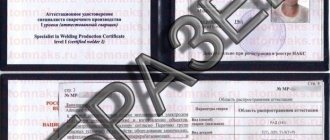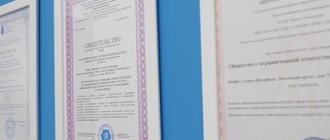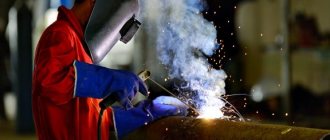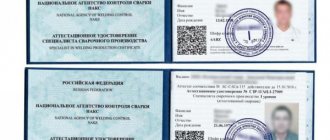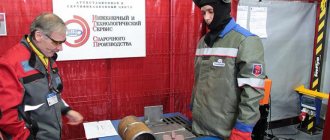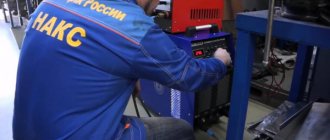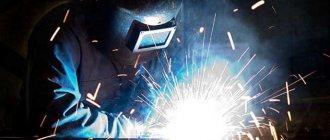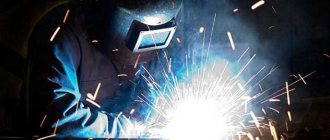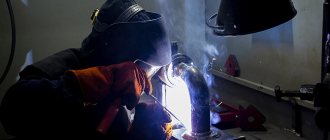Description
1.2.
Certification of welders and welding production specialists is carried out in order to establish the sufficiency of their theoretical and practical training, test their knowledge and skills and grant the right to welders and welding production specialists to perform work at facilities controlled by the Gosgortekhnadzor of Russia. 1.3. The certification system for welders and welding production specialists (CASv) is a set of requirements that define the rules and procedure for the certification of welders and welding production specialists engaged in the manufacture, reconstruction, installation and repair of equipment and facilities, supervised by the Gosgortekhnadzor of Russia.
1.4. SASv defines:
- levels of professional training of welding specialists;
- structure and principles of formation of certification bodies;
- requirements for education and special training of welders and welding production specialists;
- procedure for certification of welders;
- procedure for certification of welding production specialists;
- procedure for maintaining the register of the certification system.
1.5. SASv establishes four levels of professional training:
- Level I - certified welder;
- Level II - certified master welder;
- Level III - certified welding technologist;
- Level IV - certified welding engineer.
Assignment of a level does not cancel the assigned qualification category according to the current system according to the All-Russian Classifier of Worker Occupations, Employee Positions and Tariff Classes (OKZ 016-94), put into effect by Decree of the State Standard of Russia dated December 26, 1994 N 367.
1.6. Certified welders and welding production specialists are allowed to perform those types of activities that are specified in their certification certificates.
1.7. Welding production specialists participating in the work of certification bodies must be certified for the right to carry out work on the training and certification of welders and welding production specialists.
Special training
At least 3 months before certification, special training is carried out. Her goal:
- familiarization with the certification procedure;
- mastering the technological features of welding;
- work methods for repairing or installing specific equipment;
- methods and new methods of quality control;
- requirements for safe work.
During the training process, workers master a new welding machine and acquire skills to operate it . Managers are introduced to new technologies and their application in the manufacture of products typical of the enterprise where they work.
Applications for special training before the examination are handled by enterprise managers, simultaneously with the certification of products manufactured by welding. Welders and specialists themselves can submit an application on their own and undergo retraining if their certificate expires or if they are introducing new technologies and installing modern equipment at the site where they work.
Special training is carried out when an enterprise transitions to the production of other products.
If a worker wants to increase his grade, he undergoes special training and acquires practical skills in performing more complex types of welding.
Specialists planning to move to a higher position, for example from a foreman to a technologist, must first study the theory in courses. Then, during certification, they demonstrate their knowledge and ability to use it.
Recruitment of groups is carried out at the location of the enterprise or residence of the specialist, if he himself declares his desire to undergo special training.
Types of welder certification
Everyone working in the field of electric welding is required by law to undergo inspections as part of the rules for the certification of welders. Only after successfully passing the exams do they have the right to carry out work in their field. The work remains under the control of Russian technical supervision. Welding technology certification is divided into categories. Below you can see the certification types that people receive in any production.
Primary
Primary certification of welders is a procedure carried out by welders who have not previously had a permit.
Extraordinary
When studying information about which certification of a welder is considered extraordinary, you need to know that welders undergo it before being allowed to perform electric welding work after temporary suspension from work in case of violation of welding technology or repeated cases of poor-quality execution of electric welding connections.
Additional
People who wish to expand the work list of the certification card may obtain additional permission. Employees who have a break in their work related to their job responsibilities can also obtain permission.
Periodic
A periodic type of special inspection for welders is carried out in order to extend the period of operation of the document for work. Masters undergo a knowledge test according to the current Rules, which were approved by the country's supervision in the field of technology in 2000 (PB 03-273-99).
What is NAKS certification
Certification of welding technology NAKS is a confirmation of the professionalism of the welder. The received certificate indicates the specialist’s competence in his field, and also confirms that he is aware of safety rules, has welding techniques and can work with complex welding equipment.
The abbreviation NAKS itself stands for “National Welding Control Agency”. This organization certifies not only welders, but also engineering and technical workers related to welding work. Entry into the official NAKS register allows you to obtain permission to weld hazardous production facilities. Workers who are on this register can also count on an increase in wages.
Who needs NAKS certification
Applications for NAKS certification are submitted not only by welders and welding masters, but also by technologists and engineers.
Testing the knowledge and skills of working personnel involved in the welding industry provides for the following types of NAKS certification:
- Welder NAKS. A specialist who passes this exam receives a certificate granting permission to work at critical facilities. The responsibilities of this worker include welding of any alloys and metals in all possible spatial positions. He also performs cutting, welding and planing work. A welder certified by the National Welding Control Agency is able to apply any type of weld and make rational decisions in the event of an emergency;
- Master welder. The requirements for a master are much higher. His competence includes not only welding. He also provides supervision over the activities of other welders and advises them in writing or orally;
- Technologist. The responsibilities of the technologist include monitoring the production processes of the enterprise, including welding;
- Engineer. The engineer's responsibility is to monitor compliance with the rules that govern the welding process. The engineer is also responsible for developing the documentation that approves these rules.
Electric welding work
Types of work and locations
Technological processes of electric welding, cutting, surfacing with stationary, mobile installations, portable devices are divided into the following types:
- Dugovaya.
- Atomic-hydrogen.
- Electron beam.
- Laser.
- Plasma.
- Electroslag.
Work is carried out both indoors - at stationary welding stations, in the premises of assembly, repair, production shops, including on scaffolding installed around process equipment, and outdoors - during the installation of building metal structures; when creating and repairing industrial equipment, vehicles, pipeline networks, overpasses.
Regulations
Fire safety requirements for carrying out work on electrical welding of structures and cutting scrap metal are set out in the following regulatory documents:
- In the “PPR in the Russian Federation”, where section XVI on fire hazardous work contains the basic set of rules for organizing, conducting, and monitoring the places where electric welding is performed, including at the end of work shifts.
- In the current guidance document 34.03.307, developed in 1987, on safety rules during construction and installation work at the enterprises of the Ministry of Energy, Section 8 also clearly states safety measures when conducting electric welding work.
- In the “Rules for labor protection in the production of gas-electric welding work”, approved in 2014 by Order No. 1101n of the Ministry of Labor and Social Protection.
- In the current state standard 12.3.003, issued in 1986, on safety requirements for electric welding work.
Although the general requirements in these documents are mostly duplicated, there are also specific instructions, including those related to the places where electric welding work is carried out - at heights, inside transported containers, process tanks, equipment.
Photo: izostil.ru/photo/full/s43_2.jpg
Requirements
Fire safety during electric welding work is ensured by strict implementation of a set of organizational and technical measures set out in regulations and rules:
- Careful preparation of the work site - cleaning the site/area of the premises, the external territory of any flammable materials, including production waste, combustible garbage within the radius specified in Appendix 3 to the “PPR in the Russian Federation”.
- In this case, the smallest required radius of the cleaning zone is directly dependent on the height of the electric welding point above the floor level, the ground - from 5 m when working at the zero level to 14 m when working at a height of more than 10 m, which is associated with the scattering of drops of molten metal and hot scale , cinders.
- Before starting work, it is necessary to carry out complete emptying, draining of flammable liquids, flammable liquids from the buildings of process equipment, storage tanks, railway tanks, sections of pipeline networks for pumping liquid flammable, combustible materials, gas mixtures.
- And then wash them, treat them with hot steam, ventilate them, and measure the concentration of hazardous substances in the air to prevent an explosion and/or fire.
- Before starting work in premises that have a high explosion and fire hazard category, preliminary ventilation, constant operation of exhaust ventilation systems, and regular monitoring of the presence of flammable gases and vapors are necessary.
- If within the radius of the protective cleaning zone there are stationary structures made of combustible materials, including floor coverings, then they should be covered, curtained, covered with sheet or roll materials made of non-combustible substances, including metal screens, fire-resistant canvases/mats, or spilled water.
- The place where electric welding work is carried out in such conditions can also be separated by a temporary solid partition/screen made of non-combustible materials with a height of at least 1.8 m, with a bottom gap to the floor of no more than 50 mm, protected by a metal mesh with cells no larger than 1x1 mm.
- To prevent the fall and penetration of sparks, scale, drops of molten metal into adjacent, underlying rooms, all doors and hatches in the walls, partitions, and ceilings should be closed before starting work; protect construction, technological, and installation openings with screens and shields made of fireproof materials.
- Mandatory registration and approval by the administration of the facility where electric welding is required, a work permit for hot work in the form of Appendix 4 to the “PPR in the Russian Federation”.
- Portable, mobile fire extinguishers of the appropriate types, weight/volume of charge of fire extinguishing agents must be installed near the places of upcoming work, in accordance with the instructions of Appendix 1 to the “PPR in the Russian Federation”.
On this topic ▼
Fire safety instructions
During production, upon completion of electric welding work, the following safety precautions should be taken:
- Disconnect electric welding equipment completely, including from the mains supply, including periods of breaks in operation.
- Upon completion of work, all electric welding equipment must be removed to permanent storage areas.
- It is forbidden to start electric welding with faulty equipment or in unprepared places; allow people to work who do not have specialized education, qualification certificates, or permits to carry out work.
- Electric welding portable equipment/stationary installation must be reliably grounded.
- It is necessary to use only standard types of industrially produced electrodes that correspond to the established welding current.
- Electrode cinders must be placed in a special metal container/box, which is installed in close proximity to the electric welding point.
- It is forbidden to knock out electrode stubs on building structures, scattering them in the work area, as this often leads to the emergence of fires, development, and spread of fire, including several hours after completion of work.
- Electrical wires of welding equipment laid to the work site should not come into contact with cylinders or storage tanks for compressed/liquefied gases.
- It is prohibited to carry out work on technological equipment, sections of pipeline networks of enterprises, vehicles that are filled with flammable, toxic materials, as well as those under operating electrical voltage.
- Electric welding should not be carried out during construction and installation work on building elements, load-bearing metal structures at the same time as laying insulation materials or installing waterproofing; gluing floor coverings using organic adhesives, mastics, and varnishes.
- It is prohibited to use cables of electric welding equipment with damage to the insulating layer, or to use non-standard electrical circuit breakers.
- The connection of welding wires/cables is carried out by pressing, soldering, bolt clamps, excluding twisted contacts.
- When laying wires, ensure a safe distance to pipelines transporting oxygen of at least 0.5 m; to pipes, cylinders, tanks with flammable gases, including acetylene used in gas welding/cutting, at least 1 m.
- It is prohibited to use grounding networks of construction sites, railway rails, metal structures of buildings, utilities, and production equipment as a return conductor. To do this, use 2 wires from the electric welding equipment kit.
In general, fire safety when performing electric welding work is ensured by the serviceability of the equipment, careful preparation of the production site, qualifications, and experience of welders; constant supervision of the foreman/foreman, regular control of the site administration, including for at least 2 hours after completion.
Instructions for carrying out work
Certification of welders
Welders certified in accordance with the “Rules for the Certification of Welders and Welding Specialists” PB 03-273-99 are allowed to weld steam and hot water pipelines supervised by the Gosgortekhnadzor of Russia.
Welders who have not previously had access to welding pipelines controlled by Gosgortekhnadzor undergo primary certification.
Welders who have passed the initial certification are subject to additional certification before their admission to welding work not specified in their certification certificates, as well as after a break of more than 6 months in performing these works. At the same time, welders pass special and practical exams.
All welders undergo periodic certification in order to extend the validity of their certification certificates to perform the relevant work. During periodic certification, welders also pass special and practical exams.
Welders must undergo extraordinary certification before being allowed to work after temporary suspension. At the same time, they pass general, special and practical exams.
Welding of control joints is carried out in the presence of members of the certification commission. Control welded joints are subjected to non-destructive and destructive quality control.
Scope of certification:
- certification for welding butt welded joints of pipes applies to welding of butt welded joints of sheets;
- certification for welding butt welded joints of sheets in all spatial positions applies to welding of fixed butt welded joints of pipes with an outer diameter of 500 mm or more;
- certification for welding butt welded joints of sheets in the lower (H1) or horizontal (H) positions, as well as corner welded joints of sheets “in a boat” (H1) with or without full penetration applies to welding of butt and corner joints of pipes with an outer diameter more than 150 mm in the same positions.
The certification center issues the welder separate certification certificates for each welding method.
The welder performs control welded joints of sheets or pipes of the following types: with butt - SSh (BW) and/or fillet - USH (FW) welds. The welding positions of the control joints must correspond to those in which the welder will perform production welded joints.
Seam positions when welding sheet joints
Stykov
Corner
Seam positions when welding pipe joints
Stykov
Corner
H1 - lower with a horizontal arrangement of the axes of pipes (pipes) welded with a turn;
H2 - lower when the pipe is positioned vertically, welded without rotation or with rotation;
B1 - variable with a horizontal arrangement of the axes of pipes (pipes), welded (welded) without turning “uphill”;
B2 - variable with a horizontal arrangement of the axes of the pipes (pipes), welded (welded) without turning “downhill”;
G - horizontal with a vertical arrangement of the axes of pipes welded without rotation or with rotation;
H45 - variable with an inclined arrangement of the axes of pipes (pipes) welded (welded) without rotation.
P2 - ceiling with a vertical pipe axis, welded without rotation or with rotation
| Outer diameter of pipes, mm | The number of control connections is not less than: |
| Over 100 | 1 |
| Over 25 to 100 | 2 |
| Up to 25 | 5 |
When manual and mechanized welding in shielding gases with flux-cored wire, in order to obtain the right to perform work in all spatial positions, the welder must weld the most difficult joints. The dimensions (in mm) of control welded joints must correspond to the following values:
| t, mm | <6 | <6 |
| α,mm | ≤0.5 t | 0.5 t ≤ α ≤ z (z=0.7t) |
Training requirements
Welders are certified in 3 disciplines:
- general educational theory;
- professional knowledge;
- practical skill.
If a worker has a secondary or higher education, he is exempt from the general theory. A higher education in welding allows you to avoid taking theory in a practical subject. Knowledge of safe work methods and fire safety is taken by all workers and specialists regularly.
The ability to cook products of a certain complexity is mandatory tested by the commission on several samples of different types.
The welder undergoes a special training course in order to know all the requirements that may be placed on his ability to work. For example, is it allowed to weld the semi-perimeter of a joint during certification? For a worker certified to work with pipelines, it is permissible to weld only half of the joint, provided that the pipe has a diameter of more than 1020 mm. At the same time, he must partially capture the bottom and top and demonstrate his ability to work the ceiling.
If the pipe diameter is 25 - 100 mm, at least 2 circumferential welds are made. For pipeline connections up to 25 mm, the number of connections made is 5.
Procedure for certification of welding production specialists
The procedure for issuing a permit for electric welding work is as follows:
- The specialist sends the application to the certification service, attaching additional documents;
- Then the service checks the documents and begins the exam. The test begins with a practical test (if not passed, the welder can later pass the test, doing this no earlier than thirty days later).
- The third step is a mandatory one with an additional exam in writing or on a computer. The first test contains 20 mandatory questions and 15 optional questions. Topics are selected with the help of a specially assembled commission. They are compiled from a collection of topics. If a person was able to answer 80% of the topics correctly, then the state exam ends successfully.
- If the practical and theoretical exams are successfully passed, the commission will issue a protocol separately for the person for each welding. A conclusion with other documents responsible for quality control of welding joints will remain attached to the protocol.
The last step will be to obtain an electric welding certificate within the framework of the state example. The cover of a state standard document is made in a blue and red cover (for level 1 welders there is a blue frame, and for level 2-4 specialists there is a red frame).
Attestation process
Before confirming qualifications, the employee undergoes training and testing of knowledge on industrial safety at work. He provides the exam result to the center department. The qualification confirmation procedure includes several state exams: a single one with additional testing and practice. Employees with additional education in the production field with repairs and installation of materials from special polymer materials. They are exempt from the exam. During the certification process for management law with special technical control of electric welding work, employees pass the exam.
Simultaneous certification of employees of electric welding special production is permitted no more than within three groups of special technical facilities. Employees for the new group of technical devices take a special purpose exam.
Exam
At the first exam, the certified employee asks at least thirty questions to the certified employee, and at the additional exam, at least twenty questions and tasks in the field of industrial work. Examinations are conducted in written form. As part of the decision of the special commission accepting the exam, the certified person may receive an interview. An employee passes the mandatory exam if he answers most of the questions and successfully completes the practice assignment, taking into account an additional interview.
If an employee is certified for several working types, for example, electric arc welding or arc electric welding, the ticket for passing state exams must contain at least five topics about a special welding method. During qualification confirmation for site welding, which are classified as unsafe special technical devices, the specialist receives a specific series of tests to pass tests within each group of dangerous technical devices. The ticket must contain five questions in the group of special technical devices.
Certification of welders
Welders are subject to certification for the right to perform welding and surfacing work using specific types (methods) of fusion welding, carried out manually, mechanized (semi-automatic) and automated methods when working at facilities controlled by Rostechnadzor.
Types of certification of welders:
- Primary certification - welders who have not previously had permission pass.
- Additional certification is carried out by welders who have already passed the initial certification, but who want to expand the list of works specified in the certification certificates, or by welders who have had a break in welding work for more than six months.
- Periodic certification – all welders who have already passed certification undergo it in order to extend the validity of their certification certificates.
- Extraordinary certification - welders undergo before being allowed to perform welding after their temporary suspension from work due to violations of welding technology or repeated cases of poor-quality welded joints.
What documentation is drawn up when carrying out welding work?
The welding log is an important document in the work of professional builders. In this register, the employee keeps records of all welding work carried out at the site. Only a welder of the third category and higher has the right to conduct it. The order for its maintenance is issued by the manager and signed by the employee who is assigned to maintain it.
FILES Download a blank form of the welding work log .docDownload a sample welding work log .doc
The obligation to keep a log of welding work must be specified in the employment contract or the employee’s job description. Labor legislation in this case makes it clear that inattention is unacceptable here. After all, the level of responsibility during all construction, in particular welding, work is colossal.
How to fill out the fields
In the document, the specific names of the columns are clearly and clearly given on the title page; it is difficult to make a mistake here. So, a well-executed document may contain:
- The name of the company that performs the task.
- At what facility the welding work is performed, its address and name.
- Full name and position of the employee who performs the work and enters data on its completion in the journal (this paragraph provides a place for a signature).
- The name of the company that developed the design documentation for the work. There may be a dash in this paragraph if project activities were not carried out, and the employee acted according to ready-made diagrams and drawings.
- Project code.
- Who manufactured the connected structures.
- Full name of the representative of the customer of the welding work performed with the title and signature of the technical supervision officer.
- Dating: beginning and end of journaling.
The procedure for certification of welders:
- The employer sends an application to the certification center in the prescribed form (see Appendix 1 to RD 03-495-02).
- Certification begins with a practical exam (in case of negative results, the welder can re-pass certification no earlier than after 1 month).
- General and special examinations are conducted in written form or using a computer. The general exam consists of 20 questions on the theoretical fundamentals of welding, and the special exam consists of 15 questions depending on the type of welding for which it is certified. Questions are selected by the certification committee based on collections of exam questions. If the applicant correctly answers at least 80% of the questions, the exam is considered passed.
- In case of successful completion of practical and theoretical exams, the certification commission draws up a certification protocol separately for each person being certified for each type of welding. The report is accompanied by a conclusion or other documents with the results of quality control of control welded joints.
- The certification center issues a separate certification certificate for each type of welding according to the established sample (see Appendix 15 to RD 03-495-02).
The cover color of the metal materials welder certification certificate is blue.
The cover color of the polymer material welder is green.
Organizational structure
SASv is an independent and independent structure. It reports to RosTechnadzor, has a presidium and an extensive system. The Directorate manages federal and regional representatives, as well as groups of NAKS experts.
The second branch of the organization is the technical council. It consists of 10 committees in different areas of activity.
Certification is carried out in several directions. Materials, equipment and technologies used must be checked.
Each direction has certification centers. The responsibilities of the personnel certification branch include organizing commissions and retraining personnel.
Certification of welding production specialists
Certification of welding production specialists of levels II, III and IV is carried out in accordance with the direction of their production activities in the manufacture, installation, reconstruction and repair of equipment, pipelines and structures controlled by Rostechnadzor.
Types of activities of welding production specialists for which their certification is carried out:
- management and technical control of welding work;
- participation in the work of bodies for the training and certification of welders and welding production specialists.
Seam positions when welding sheet joints
Stykov
Corner
Seam positions when welding pipe joints
Stykov
Corner
H1 - lower with a horizontal arrangement of the axes of pipes (pipes) welded with a turn;
H2 - lower when the pipe is positioned vertically, welded without rotation or with rotation;
B1 - variable with a horizontal arrangement of the axes of pipes (pipes), welded (welded) without turning “uphill”;
B2 - variable with a horizontal arrangement of the axes of the pipes (pipes), welded (welded) without turning “downhill”;
G - horizontal with a vertical arrangement of the axes of pipes welded without rotation or with rotation;
H45 - variable with an inclined arrangement of the axes of pipes (pipes) welded (welded) without rotation.
P2 - ceiling with a vertical pipe axis, welded without rotation or with rotation
| Outer diameter of pipes, mm | The number of control connections is not less than: |
| Over 100 | 1 |
| Over 25 to 100 | 2 |
| Up to 25 | 5 |
When manual and mechanized welding in shielding gases with flux-cored wire, in order to obtain the right to perform work in all spatial positions, the welder must weld the most difficult joints. The dimensions (in mm) of control welded joints must correspond to the following values:
| t, mm | <6 | <6 |
| α,mm | ≤0.5 t | 0.5 t ≤ α ≤ z (z=0.7t) |
‹ Welding materials Contents Preparation of pipe joints for welding ›
Gas welding and metal cutting work
Types and venues
Work on gas cutting, joining by melting metal parts of equipment, commercial products is carried out at permanent places in welding workshops, posts, specially designated areas of production, mechanical repair, assembly shops equipped for these purposes; during routine repairs during planned shutdowns of process units. A large volume of gas welding work is also carried out on the construction of various objects, during the reconstruction of load-bearing metal frames of buildings.
Gas cutting is used both for preparing sections of pipes and structural elements, and in the process of bringing large-sized scrap metal into a condition suitable for transportation on vehicles.
In all cases, ensuring safety during gas welding operations is one of the main conditions for the possibility of carrying out such activities due to the high fire hazard of the process; a huge annual number of fires recorded by the Ministry of Emergency Situations of the Russian Federation, due to violation of safety requirements by gas welders, weak control by the administration of protection facilities.
Photo: izostil.ru/photo/full/s43_3.jpg
Documentation
A set of requirements for organizing and carrying out gas welding work is set out in several official documents at both the federal and departmental levels:
- Section XVI “PPR in the Russian Federation”, which establishes requirements for the performance of fire hazardous work, regardless of the location.
- In the safety rules for hot work, approved by the Federal Technical Supervision Service.
- In the “Rules on labor protection when carrying out gas-electric welding work, approved by Order No. 1101n of the Ministry of Labor and Social Protection in 2014.
- In the rules of industrial safety during construction work at energy industry facilities.
- GOST R 14175-2010 – on gases and gas mixtures used for welding metals.
These documents are used in the training of gas welders, engineering service specialists, those responsible for the fire safety of facilities that control the implementation of such work, as part of fire safety briefings, and training under PTM programs.
Regulatory Requirements
Particular attention in the fire safety rules during the performance of these fire-hazardous works is given to monitoring professional training, qualifications of gas welders, and preparation of venues:
- Thus, only specialists who have qualification certificates and have undergone a preliminary medical examination, instructions on fire safety, and safety precautions are allowed to carry out work on cutting and welding of metal structures and equipment parts; were trained in methods and techniques of gas welding with on-site training, with testing of the scope of knowledge in the form of tests/exams, carried out at least once a year.
- To carry out gas welding and cutting work at temporary sites, excluding construction sites, private households, the head or person responsible for fire safety of the organization at the place of execution must be properly filled out and signed a work permit for hot work in accordance with the established form of Appendix No. 4 “PPR in the Russian Federation” "
- The territory of the place where gas welding works are carried out within a radius depending on the height of the work specified in Appendix No. 3 “PPR in the Russian Federation” is thoroughly cleared of all flammable materials - raw materials, garbage, finished products; and combustible building structures, floor surfaces, finishing, cladding, insulation, elements of production equipment made of flammable substances are protected from contact with fire, sparks by metal screens, fire-resistant canvases, and if necessary, sprinkled with water.
- It is unacceptable to carry out gas-flame work from stepladders and ladders, as well as to use gas cylinders and electric welding equipment together inside the buildings of process equipment, storage tanks, and transportation.
- It is prohibited to store flammable liquids, including flammable liquids and other flammable materials, closer than 5 m from the work site.
- If it is necessary to carry out gas welding work at a height of more than 5 m, then scaffolding and platforms made of non-combustible materials should be installed for these purposes.
- When several workers are simultaneously working on scaffolding along the same vertical line, it is necessary to protect people and gas equipment from molten drops of metal. At the same time, places where gas welding works are carried out on all tiers, in the absence of fireproof protective flooring, are cleared of flammable materials within a radius of at least 5 m, and from explosive substances and equipment - at least 10 m.
- To prevent hot drops and parts of metal structures from reaching the underlying floors during gas welding work, all technological openings, hatches, and openings in the main building structures should be covered with non-combustible materials in adjacent rooms.
On this topic ▼
Fire safety in the workplace
Before starting gas welding work, workers must check:
- Serviceability of gas equipment, including control and measuring equipment.
- Tightness of all connections along the line from the cylinders to the gas cutter/burner.
- Availability and serviceability of primary fire extinguishing means.
Gas welding and metal cutting can be performed at a horizontal distance of no less than:
- 5 m – from cylinders with combustible gases, O2.
- 10 m - from groups of cylinders, numbering more than 2, which are intended for performing gas-flame work.
- 3 m during manual work - from pipelines with flammable gases, as well as from metal cabinets in which cylinders with flammable gas mixtures are installed.
During the work it is necessary:
- Remove anti-corrosion primers, flammable paints, coatings, enamels from the surfaces of welded construction workpieces and equipment parts to a width of at least 0.1 m from the welding site.
- Before a break in work, at the end of the working day/shift, gas equipment should be brought into a fire-safe state - close the valves, disconnect the hoses, freeing them from flammable gases.
Upon completion of work, all gas equipment should be moved to special rooms/locations designated for these purposes.
Safety during welding work
When performing any type of gas-flame work, it is prohibited:
- Allow apprentice gas welders and enterprise workers without qualification certificates to work independently.
- Proceed with them without a routine check of serviceability, as well as if faults are identified, violations of operating rules - damage to housings, valves, adapters; with expired inspection periods, if a leak is detected at any connection point.
- Carry out work on building structures, parts of production equipment, and products recently painted with flammable primers, paints, and varnishes.
- Use protective clothing and protective gloves contaminated with vegetable fats, oils, petroleum products, and other flammable liquids.
- Allow cylinders with flammable gases, O2 to come into contact with electrical cables and wires.
- Perform work on the housings of process equipment, storage tanks, piping, communications that are filled with flammable, toxic materials, or are under electrical voltage; as well as on elements of construction projects that are made of lightweight metal structures with combustible, difficult-to-burn insulation.
Fire safety requirements, closely related to work safety, occupy a large volume of training programs for gas welders, and an annual knowledge test allows one to refresh their knowledge of fire safety rules.
However, the management of construction and installation enterprises, the administration responsible for the fire safety of facilities where such fire-hazardous work must be carried out, should not rely solely on the consciousness of workers; and carefully check the preparation of the venues, the condition of the equipment, and the compliance of gas welders with industrial safety requirements.
Welding specialists who must undergo certification:
- at level II: specialists whose written or oral instructions are mandatory for welders to carry out when carrying out welding work (foremen, foremen, etc.);
- at level III: specialists who are heads of individual departments of the enterprise that ensure the implementation of welding work, and whose signature is necessary and sufficient for the use of documents defining the technology of welding work at the enterprise (heads of departments, laboratories, sectors, technical bureaus, heads of working groups, etc. .P.); at level IV: specialists who are managers of the welding service of an enterprise (organization), whose signature is necessary and sufficient for the management of the enterprise (organization) to approve guidelines and regulatory documents for the performance of all types of welding work (chiefs, their deputies, etc.).
The procedure for certification of welding production specialists:
- The employer submits an application in the prescribed form to the certification center (see Appendix 18 to RD 03-495-02).
- Certification begins with a general exam, during which the specialist is asked 30 questions.
- A special exam is conducted, which consists of 20 questions and a practical task in accordance with the direction of production activity of a welding specialist.
- If the number of correct answers in the exams exceeds 80%, then the specialist is considered certified and, based on the results of the certification, minutes of the meeting of the certification commission are drawn up.
- Certified specialists are issued certificates of welding production specialists.
The cover color of the welding production specialist certification certificate is red.
Sources
- https://tk-servis.ru/lib/83/
- https://mrmetall.ru/attestacija-svarshhikov-i-specialistov-dlja-chego-ona-kak-proishodjat-vidy-attestacii/
- https://BurForum.ru/metally-svarka/vidy-attestacii-svarshchikov.html
- https://www.fsetan.ru/podgotovka-i-attestaciya-rabotnikov/svarshhiki-i-specialisty-svarochnogo-proizvodstva/
- https://weldering.com/attestaciya-svarshchikov
